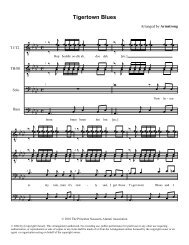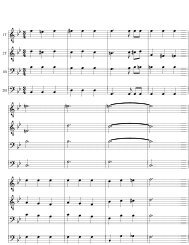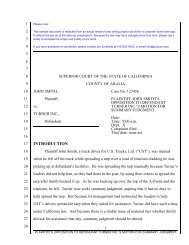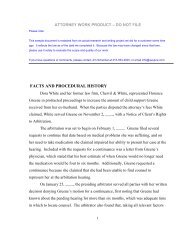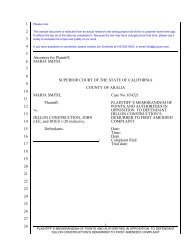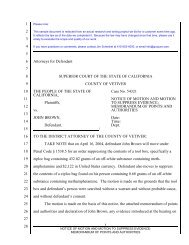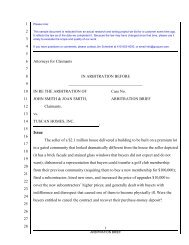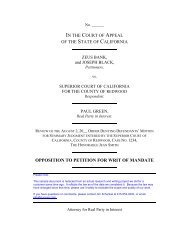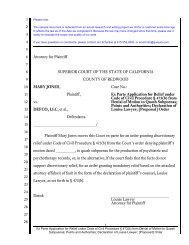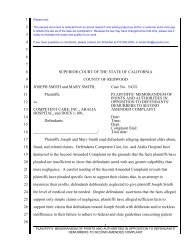Demurrer - Quo Jure Corporation
Demurrer - Quo Jure Corporation
Demurrer - Quo Jure Corporation
You also want an ePaper? Increase the reach of your titles
YUMPU automatically turns print PDFs into web optimized ePapers that Google loves.
1<br />
2<br />
3<br />
4<br />
5<br />
6<br />
7<br />
8<br />
9<br />
10<br />
11<br />
12<br />
13<br />
14<br />
15<br />
16<br />
17<br />
18<br />
19<br />
20<br />
21<br />
22<br />
23<br />
24<br />
25<br />
26<br />
27<br />
28<br />
Please note:<br />
This sample document is redacted from an actual research and writing project we did for a customer some time ago.<br />
It reflects the law as of the date we completed it. Because the law may have changed since that time, please use it<br />
solely to evaluate the scope and quality of our work.<br />
If you have questions or comments, please contact Jim Schenkel at 415-553-4000, or email info@quojure.com.<br />
Attorneys for Defendant<br />
JOHNSON DRYWALL<br />
JOSEPH LEE and<br />
HELEN LEE,<br />
vs.<br />
Plaintiffs,<br />
SUPERIOR COURT OF THE STATE OF CALIFORNIA<br />
CONNOR CONSTRUCTION, INC.,<br />
et al.,<br />
Defendants.<br />
INTRODUCTION<br />
COUNTY OF REDWOOD<br />
/<br />
Case No. 999999<br />
1<br />
DEMURRER TO COMPLAINT<br />
DEMURRER TO COMPLAINT<br />
Date:<br />
Time:<br />
Dept.<br />
Complaint filed:<br />
Trial date:<br />
The complaint here at issue arises out of construction of a custom home for<br />
plaintiffs by a general contractor (Connor Construction, Inc.) and numerous<br />
subcontractors, including defendant Beta Drywall. Plaintiffs originally brought<br />
arbitration proceedings against Connor and recovered a net arbitration award (including<br />
attorney’s fees and interest) of $1,584,000 based on construction defects. Beta has<br />
requested that the court from its own files take judicial notice of the award, and of the fact<br />
that it has been fully satisfied.<br />
On April 30, 2001, while the arbitration was pending, plaintiffs filed an action in<br />
this court against Connor Construction, Inc. (Santa Lucia County Superior Court No.<br />
01234). The second amended complaint in that action alleges fraud, negligent
1<br />
2<br />
3<br />
4<br />
5<br />
6<br />
7<br />
8<br />
9<br />
10<br />
11<br />
12<br />
13<br />
14<br />
15<br />
16<br />
17<br />
18<br />
19<br />
20<br />
21<br />
22<br />
23<br />
24<br />
25<br />
26<br />
27<br />
28<br />
misrepresentation, negligence, negligent infliction of emotional distress, intentional<br />
infliction of emotional distress, RICO violations, breach of contract, and breach of<br />
warranty. Connor Construction filed a cross-complaint against numerous subcontractors,<br />
including Beta. Beta has answered the cross-complaint.<br />
Plaintiffs filed the instant action (No. 43210) on July 18, 2002. The complaint<br />
names as defendants the various subcontractors who worked on the construction project,<br />
including Beta. It attempts to allege claims for fraud, negligent misrepresentation,<br />
negligence, breach of contract, and breach of warranty. Although it does not explicitly so<br />
state, each claim appears to be against all defendants. The instant action and Case No.<br />
01234 were consolidated by Pre-Trial Order No. 4 (in that case), but Beta has only now<br />
been served with the instant complaint.<br />
The complaint is insufficient in numerous respects. The first and second claims<br />
for fraud and negligent misrepresentation are based on conduct by three named defendant<br />
subcontractors, none of which has any connection to Beta. The only allegations that<br />
might possibly connect Beta to the alleged fraud are a one-sentence boilerplate agency<br />
allegation too conclusory to support a cause of action against Beta under the<br />
circumstances, and an allegation that the Construction Contract between plaintiffs and<br />
Connor somehow imposed duties on Beta.<br />
The third claim for negligence fails to state a cause of action against Beta because<br />
it is based on breach of duties allegedly imposed on Beta by the Construction Contract<br />
between plaintiffs and Connor, to which Beta is not a party, and because it fails to allege<br />
any negligent act by Beta, or that such act proximately caused damage to plaintiffs. The<br />
third claim is also barred by res judicata because it asserts the same claim for construction<br />
defects that plaintiffs asserted (and on which they recovered) in the arbitration against<br />
Connor.<br />
The fourth and fifth claims for breach of contract and breach of warranty are<br />
uncertain in that it cannot be determined whether plaintiffs are alleging breach of the<br />
2<br />
DEMURRER TO COMPLAINT
1<br />
2<br />
3<br />
4<br />
5<br />
6<br />
7<br />
8<br />
9<br />
10<br />
11<br />
12<br />
13<br />
14<br />
15<br />
16<br />
17<br />
18<br />
19<br />
20<br />
21<br />
22<br />
23<br />
24<br />
25<br />
26<br />
27<br />
28<br />
Construction Contract between plaintiffs and Connor, or breach of the subcontract<br />
between Connor and Beta. To the extent plaintiffs allege breach of the Construction<br />
Contract, no cause of action is stated because Beta is not a party to that contract. If<br />
plaintiffs’ intention was to allege breach of the subcontract, they have failed to make any<br />
clear allegation to that effect. Moreover, it cannot be determined whether the subcontract<br />
sued upon is written, oral, or implied from conduct.<br />
ARGUMENT<br />
1. The first and second claims fail to connect Beta with the alleged fraud<br />
and/or negligent misrepresentation, and therefore fail to state claims<br />
against Beta.<br />
Plaintiffs’ fraud and negligent misrepresentation claims are based on three<br />
specifically alleged acts. The first is that “[d]efendants Jones Construction and Does One<br />
through Ten” represented to plaintiffs that “defendants” had subcontracted with Jones in<br />
the amount of $154,151; that “defendants” invoiced plaintiffs in that amount; and that<br />
“defendants” paid Jones only $149,151. The second is that “[d]efendant Lee Wood<br />
Windows and Does Eleven through Twenty” represented to plaintiffs that “defendants”<br />
would install Kolbe & Kolbe windows and doors; that “defendants” invoiced plaintiffs<br />
based on bids for Kolbe & Kolbe windows and doors; and that “defendants” installed<br />
inferior “knock offs.” Lastly, plaintiffs allege that “[d]efendants John Brown,<br />
individually and dba Brown Painting Co., Does Twenty-One through Thirty, and each of<br />
them,” wrongfully concealed certain facts from plaintiffs regarding an insurance claim;<br />
and that “[e]ach named defendant” concealed the facts with the intent to defraud<br />
plaintiffs.<br />
The complaint nowhere alleges that Beta participated in or had any knowledge of<br />
these alleged fraudulent acts. Nevertheless, plaintiffs’ repeated allegation that<br />
“defendants” committed the acts indicates an intention to charge all named defendants,<br />
3<br />
DEMURRER TO COMPLAINT
1<br />
2<br />
3<br />
4<br />
5<br />
6<br />
7<br />
8<br />
9<br />
10<br />
11<br />
12<br />
13<br />
14<br />
15<br />
16<br />
17<br />
18<br />
19<br />
20<br />
21<br />
22<br />
23<br />
24<br />
25<br />
26<br />
27<br />
28<br />
including Beta. Only two allegations could possibly connect Beta with the alleged fraud,<br />
but neither is sufficient to state a cause of action.<br />
The first is a generic agency allegation: “At all material times described below,<br />
defendants each acted as the agents, employees and joint venturers of one another in the<br />
acts and omissions described below.” A general allegation of agency is one of ultimate<br />
fact and is usually sufficient against a demurrer. Kiseskey v. Carpenters’ Trust for So.<br />
California (1983) 144 Cal.App.3d 222, 230. But under certain circumstances such<br />
boilerplate pleading may be deemed too conclusory to charge a particular defendant.<br />
In Moore v. Regents of the University of California (1990) 51 Cal.3d 120, a<br />
leukemia patient treated at the U.C.L.A. Medical Center sued after learning that a<br />
patented cell line, developed from his cells without his knowledge or consent, was being<br />
commercially exploited. The plaintiff’s complaint alleged claims for conversion, breach<br />
of fiduciary duty, lack of informed consent, and numerous other wrongs against Golde<br />
(the physician who treated him at the Center), the Regents (who owned and operated the<br />
Center), Quan (a researcher employed by the Regents), and Genetics Institute, Inc. and<br />
Sandoz Pharmaceutical <strong>Corporation</strong>, two companies that, after the cell line was<br />
developed and patented, contracted with Golde and the Regents for its commercial use.<br />
The complaint included a boilerplate agency allegation that each defendant was the<br />
other's agent, etc.<br />
When the defendants demurred to the complaint, the trial court considered only the<br />
first cause of action for conversion, which it concluded did not state a cause of action.<br />
Reasoning that all the other causes of action incorporated the earlier defective allegations,<br />
the trial court sustained general demurrers to the entire complaint with leave to amend. In<br />
a later proceeding, the trial court sustained Genetics Institute’s and Sandoz’s demurrers<br />
without leave to amend on the ground that the plaintiff had failed to state a cause of<br />
action for conversion “and that the complaint’s allegations about the entities’ secondary<br />
liability were too conclusory.” Id., at 128. The court of appeal reversed, holding that the<br />
4<br />
DEMURRER TO COMPLAINT
1<br />
2<br />
3<br />
4<br />
5<br />
6<br />
7<br />
8<br />
9<br />
10<br />
11<br />
12<br />
13<br />
14<br />
15<br />
16<br />
17<br />
18<br />
19<br />
20<br />
21<br />
22<br />
23<br />
24<br />
25<br />
26<br />
27<br />
28<br />
complaint did state a cause of action for conversion, and directed the trial court to decide<br />
the other causes of action it had never expressly ruled upon. As to the secondary liability<br />
(i.e., agency) allegations, the court of appeal “agreed with the superior court that the<br />
allegations against Genetics Institute and Sandoz were insufficient,” but it directed the<br />
trial court to grant plaintiff leave to amend them. Ibid.<br />
The supreme court reversed the court of appeal’s decision. It concluded that the<br />
complaint did not state a cause of action for conversion and directed that defendants’<br />
demurrers to that cause of action be sustained without leave to amend. Id., at 148. But it<br />
held that the complaint did state causes of action against Golde for breach of fiduciary<br />
duty and lack of informed consent, and directed that Golde’s demurrers to those causes of<br />
action be overruled. Ibid. It further directed that the Regents’, Quan’s, Genetics<br />
Institutes’, and Sandoz’s demurrers to those causes of action be sustained with leave to<br />
amend. Ibid. As to Sandoz and Genetics Institute, who could only be liable on those<br />
causes of action if Golde were acting as their agent, the supreme court agreed with the<br />
court of appeal that the agency allegations, which it excoriated as “egregious examples of<br />
generic boilerplate,” were too conclusory. Id., at 134, fn. 12, and accompanying text. It<br />
therefore affirmed that portion of the court of appeal’s decision. Ibid.<br />
In Moore, all three courts apparently concluded that Genetics Institute and Sandoz<br />
had so little connection with the alleged wrongful acts that fairness precluded holding<br />
them as defendants based solely on conclusory agency allegations. In the instant action,<br />
the relation between plaintiffs’ fraud allegations and Beta is similar.<br />
By their conclusory agency allegation, plaintiffs apparently are attempting to assert<br />
that the subcontractors named as having committed the fraudulent acts, while working on<br />
aspects of the construction project having no connection with Beta, were nevertheless<br />
acting as Beta’s agents. Such a relationship between subcontractors would be extremely<br />
unusual. See, e.g., La Jolla Village Homeowners’ Assn. v. Superior Court (1989) 212<br />
Cal.App.3d 1131, 1144 (“The subcontractor customarily performs one task which is<br />
5<br />
DEMURRER TO COMPLAINT
1<br />
2<br />
3<br />
4<br />
5<br />
6<br />
7<br />
8<br />
9<br />
10<br />
11<br />
12<br />
13<br />
14<br />
15<br />
16<br />
17<br />
18<br />
19<br />
20<br />
21<br />
22<br />
23<br />
24<br />
25<br />
26<br />
27<br />
28<br />
integrated into a whole. It does not control the trades which precede or follow it on the<br />
job.”). 1<br />
If plaintiffs have some basis for believing that such an agency relationship<br />
actually existed, they should be required to plead it. Otherwise, Beta should not be<br />
required to answer for the fraud of parties with whom it has no relationship whatever.<br />
The only other allegation that might possibly tie Beta to the alleged fraud relates to<br />
the terms of the “Construction Contract.” Paragraph 24 of the complaint alleges that the<br />
general contractor, Connor, entered into a written contract with plaintiffs, which it dubs<br />
the “Construction Contract.” Paragraph 25 alleges that the<br />
Construction Contract established affirmative duties on the part of any<br />
subcontractor hired by Connor Construction, Inc., to be bound to the<br />
Construction Contract and assume all obligations and responsibilities with<br />
Connor Construction by the written contract assumed toward the plaintiffs as<br />
set forth by Article 5 of the Construction Contract, including but not limited<br />
to duties to coordinate and supervise all construction . . . .”<br />
Complaint, 25, at 7:21-8:2. 2<br />
This allegation cannot form the basis of any claim of liability against Beta. The<br />
complaint alleges that plaintiffs and Connor entered into the Construction Contract, and<br />
1 The converse—i.e., that Beta was the named-subcontractors’ agent—would be equally<br />
unusual, but would still be insufficient absent additional allegations. An agent is not liable for the<br />
principal’s fraud unless the agent knew of or participated in the fraud. Mars v. Wedbush Morgan<br />
Securities, Inc. (1991) 231 Cal.App.3d 1608, 1616; 2 Witkin, SUMMARY OF CAL. LAW (9th ed. 1987)<br />
Agency and Employment, §145, at 141. Thus, even if the conclusory agency allegation were<br />
accepted as a sufficient allegation that Beta was the named subcontractors’ agent, the complaint still<br />
would not state a fraud cause of action against it absent additional allegations that Beta knew of or<br />
participated in the fraud.<br />
2<br />
In fact, plaintiffs are referring to Article 5 of the General Conditions incorporated into the<br />
Construction Contract, and their characterization of its provisions is inaccurate. If plaintiffs had<br />
attached a copy of the Construction Contract to the complaint and incorporated it by reference, or if<br />
there were a complete copy of the Construction Contract (including Article 5 of the General<br />
Conditions) in the court’s records that could be judicially noticed, Beta could move to strike the<br />
allegations that contradict the writing. Pacific States Enterprises, Inc. v. City of Coachella (1993) 13<br />
Cal.App.4th 1414, 1426 fn. 8.<br />
6<br />
DEMURRER TO COMPLAINT
1<br />
2<br />
3<br />
4<br />
5<br />
6<br />
7<br />
8<br />
9<br />
10<br />
11<br />
12<br />
13<br />
14<br />
15<br />
16<br />
17<br />
18<br />
19<br />
20<br />
21<br />
22<br />
23<br />
24<br />
25<br />
26<br />
27<br />
28<br />
that Beta entered into a subcontract with Connor. Since Beta is not a party to the<br />
Construction Contract, that contract cannot “establish affirmative duties” on Beta’s part.<br />
Gold v. Gibbons (1960) 178 Cal.App.2d 517, 519; Acret, ATTORNEY’S GUIDE TO<br />
CALIFORNIA CONSTRUCTION AND DISPUTES (CEB 2nd ed. 1990) §3.73, at 201. Thus,<br />
even if the Construction Contract purported to make Beta responsible for some other<br />
subcontractor’s conduct, it simply could not do so.<br />
In short, the first and second claims seek to hold Beta vicariously liable for other<br />
subcontractors’ alleged fraud. Under the circumstances of this case, plaintiff’s<br />
conclusory agency allegation is insufficient, and no such liability may be founded on any<br />
provision of the Construction Contract because Beta is not a party to it. The first and<br />
second claims therefore fail to state a cause of action against Beta, and Beta’s demurrers<br />
thereto must be sustained.<br />
2. The third claim for negligence fails to state facts sufficient to constitute<br />
a cause of action, and is barred by the doctrine of res judicata.<br />
Beta’s demurrer to the third claim for negligence must be sustained on two<br />
separate grounds: (1) plaintiffs have failed to allege the necessary elements of a cause of<br />
action for negligence, and (2) plaintiffs’ negligence claim is barred by the doctrine of res<br />
judicata. See, e.g., Castro v. Higaki (1994) 31 Cal.App.4th 350 (defense of res judicata<br />
may be asserted by demurrer).<br />
A. Failure to allege the elements of negligence<br />
To set forth a claim for negligence adequately, a complaint must allege: “(1)<br />
defendant’s legal duty of care toward plaintiff, (2) defendant’s breach of duty (the<br />
negligent act or omission), (3) injury to plaintiff as a result of the breach (proximate or<br />
legal cause), and (4) damage to plaintiff.” Wise v. Superior Court (1990) 222 Cal.App.3d<br />
1008, 1013. Plaintiffs’ Third Cause of Action fails to satisfy these requirements.<br />
7<br />
DEMURRER TO COMPLAINT
1<br />
2<br />
3<br />
4<br />
5<br />
6<br />
7<br />
8<br />
9<br />
10<br />
11<br />
12<br />
13<br />
14<br />
15<br />
16<br />
17<br />
18<br />
19<br />
20<br />
21<br />
22<br />
23<br />
24<br />
25<br />
26<br />
27<br />
28<br />
First, it alleges that “defendants” owed plaintiffs a duty of care under the<br />
Construction Contract. Negligent performance of a contract may constitute a tort, i.e.,<br />
that the duty breached, for negligence purposes, may arise out of a contract. Eads v.<br />
Marks (1952) 39 Cal.2d 807, 810-811. But Beta is not a party to the Construction<br />
Contract. Thus, that contract cannot be the source of any duty forming the basis of a<br />
negligence claim against Beta.<br />
Second, the third claim alleges that defendants “failed, refused, and neglected to<br />
perform the obligations under the Construction Contract, as more fully described above.”<br />
The only failures to perform “described above” are set forth in paragraph 25 of the<br />
complaint. 3<br />
It alleges numerous construction defects (cracked tile and marble, defective<br />
welding, defective plumbing, etc.), but nowhere is there any allegation of a defect related<br />
to the drywall Beta installed. Absent some allegation that Beta committed a negligent act,<br />
i.e., breached a duty, the complaint does not state a cause of action against Beta for<br />
negligence. See, La Jolla Village, supra, 212 Cal.App.3d at 1145 (in refusing to extend<br />
strict liability to subcontractors, the court noted that subcontractors may still be held<br />
liable on conventional contract and negligence theories “[i]f the alleged construction<br />
defect results from the fault of a subcontractor.”).<br />
Finally, since the Third Cause of Action does not allege any negligent act on<br />
Beta’s part, it necessarily fails to allege that Beta’s negligence proximately caused injury<br />
to plaintiffs.<br />
B. Res judicata<br />
In the arbitration between plaintiffs and Connor, the arbitrator awarded plaintiffs<br />
the cost to repair construction defects “as estimated by Adamson Associates, including an<br />
3<br />
Plaintiffs may argue that the charging allegation also refers to the wrongs alleged in the first<br />
and second claims for fraud and negligent misrepresentation, but the complaint alleges no facts that<br />
would make Beta responsible for those wrongs.<br />
8<br />
DEMURRER TO COMPLAINT
1<br />
2<br />
3<br />
4<br />
5<br />
6<br />
7<br />
8<br />
9<br />
10<br />
11<br />
12<br />
13<br />
14<br />
15<br />
16<br />
17<br />
18<br />
19<br />
20<br />
21<br />
22<br />
23<br />
24<br />
25<br />
26<br />
27<br />
28<br />
amount for contingency, material escalation and the rework contractors’ overhead and<br />
profit.” Connor paid the arbitration award within days after its entry.<br />
Adamson Associates’ cost estimate shows that plaintiffs were compensated for<br />
most, if not all, of the defects alleged in the present complaint. For example, the estimate<br />
includes replacement of the “knock off” windows and doors with Kolbe & Kolbe<br />
products as called for in the original plans and specifications. As to the drywall Beta<br />
installed, virtually every page of the cost estimate includes demolition and/or replacement<br />
of “gypsum wallboard.”<br />
The doctrine of res judicata has two aspects. Where a plaintiff has obtained a<br />
judgment, a second action on the same claim is precluded because the cause of action is<br />
merged in the judgment. 7 Witkin, CAL. PROCEDURE (3rd ed. 1985) "Judgment," §189, at<br />
622-623. This is known as “claim preclusion,” and bars reconsideration “not only of all<br />
matters actually raised in the first suit but also matters which could have been raised.”<br />
Eichman v. Fotomat Corp. (1983) 147 Cal.App.3d 1170, 1175.<br />
The doctrine’s second aspect is referred to as “collateral estoppel.” It provides that<br />
in a new action on a different cause of action, the prior judgment is conclusive on matters<br />
actually litigated in the former action. 7 Witkin, supra. Beta submits that plaintiffs’ third<br />
claim asserts the same cause of action as the arbitration against Connor, and that it is<br />
barred as res judicata. But even if it were determined that the third claim somehow<br />
presents a different claim, the doctrine of collateral estoppel would bar any claim it<br />
purports to state against Beta for defective drywall work.<br />
The doctrine of res judicata applies to arbitration proceedings as well as judicial<br />
proceedings. Lyons v. Security Pacific Nat. Bank (1995) 40 Cal.App.4th 1001, 1015.<br />
Specifically, a prior arbitration between homeowners and a general contractor regarding<br />
construction defects precludes the homeowners’ later court action against a subcontractor.<br />
Thibodeau v. Crum (1992) 4 Cal.App.4th 749.<br />
In Thibodeau, a general contractor and various subcontractors constructed a house.<br />
9<br />
DEMURRER TO COMPLAINT
1<br />
2<br />
3<br />
4<br />
5<br />
6<br />
7<br />
8<br />
9<br />
10<br />
11<br />
12<br />
13<br />
14<br />
15<br />
16<br />
17<br />
18<br />
19<br />
20<br />
21<br />
22<br />
23<br />
24<br />
25<br />
26<br />
27<br />
28<br />
The homeowners complained of numerous construction deficiencies and initiated<br />
arbitration proceedings against the general contractor. The arbitrator’s award included<br />
$2,261 to the homeowners for the concrete driveway's repair. Six to eight months after<br />
the arbitration, the homeowners hired a concrete expert who concluded that the repairs to<br />
the driveway would cost far more. The homeowners then brought suit against Crum, the<br />
concrete subcontractor, to recover for the additional repairs. The trial court rejected<br />
Crum’s res judicata defense, but the appellate court reversed. It concluded that the prior<br />
arbitration precluded the homeowners’ claim (i.e., did not just have collateral estoppel<br />
effect) because the arbitration encompassed all claims for construction deficiencies<br />
arising out of the project. With specific reference to the driveway, the court stated:<br />
“[T]he two proceedings here involve the same homeowner, the same home, and the same<br />
driveway. The Thibodeaus were obliged to assert their various claims of damage to the<br />
driveway in one proceeding.” Id., at 757.<br />
The same reasoning applies in the present case. All claims for construction defects<br />
were encompassed in the arbitration between plaintiffs and Connor, and the award<br />
included sums for demolition and replacement of drywall. The instant negligence claim<br />
against Beta is therefore barred as res judicata.<br />
Plaintiffs may argue that Beta’s demurrer to the third claim should be denied for<br />
the same reasons that the court denied Connor’s motion for summary judgment and<br />
summary adjudication in Case No. 01234, in which Connor argued that the prior<br />
arbitration barred that action under the doctrine of res judicata. But review of plaintiffs’<br />
second amended complaint against Connor in that action, and the court’s order denying<br />
Connor’s motion, shows that the earlier ruling is not dispositive of Beta’s res judicata<br />
defense.<br />
The second amended complaint in Case No. 01234 alleges claims against Connor<br />
for fraud (including billing irregularities as well as construction defects), negligent<br />
misrepresentation, negligence, negligent and intentional infliction of emotional distress,<br />
10<br />
DEMURRER TO COMPLAINT
1<br />
2<br />
3<br />
4<br />
5<br />
6<br />
7<br />
8<br />
9<br />
10<br />
11<br />
12<br />
13<br />
14<br />
15<br />
16<br />
17<br />
18<br />
19<br />
20<br />
21<br />
22<br />
23<br />
24<br />
25<br />
26<br />
27<br />
28<br />
RICO violations, breach of contract, and breach of warranty. In its ruling on Connor’s<br />
motion, the court first noted that whether the second amended complaint asserts the same<br />
cause of action as that involved in the arbitration proceeding depends on whether it is<br />
based on the same “primary right,” i.e., whether it seeks to recover for the same harm.<br />
The court then concluded that “fraud, emotional distress and the RICO violations are<br />
different primary rights and different issues with different harm” than the claim for repair<br />
costs asserted in the arbitration. Id., at 3:10-12. It therefore held that res judicata did not<br />
bar the action against Connor, and denied Connor’s motion for summary judgment and<br />
summary adjudication. 4<br />
But the court also denied plaintiffs’ cross-motion for summary<br />
adjudication as to Connor’s Eighth Affirmative Defense (res judicata and collateral<br />
estoppel) because the arbitration ruling “may operate as an estoppel or conclusive<br />
adjudication as to such issues in this proceeding as were actually litigated and determined<br />
in the first action.”<br />
As the court noted in ruling on Connor’s motion in Case No. 01234, whether a<br />
claim is the same as or different from a claim previously adjudicated depends on whether<br />
it is based on the same primary right. “California has consistently applied the ‘primary<br />
rights’ theory, under which the invasion of one primary right gives rise to a single cause<br />
of action.” Bay Cities Paving & Grading, Inc. v. Lawyers’ Mutual Ins. Co. (1993) 5<br />
Cal.4th 854, 860, quoting from Slater v. Blackwood (1975) 15 Cal.3d 791, 795. The<br />
primary right involved is determined by the injury suffered. “[T]he ‘cause of action’ is<br />
based upon the harm suffered, as opposed to the particular theory asserted by the litigant<br />
. . . . Even where there are multiple legal theories upon which recovery might be<br />
predicated, one injury gives rise to only one claim for relief.” Ibid. And seeking different<br />
remedies, like asserting different legal theories of liability, does not convert one cause of<br />
4<br />
Although Connor’s motion sought summary adjudication as to each cause of action, the<br />
court’s ruling does not address those that are not based on fraud, emotional distress and RICO, or<br />
explain why summary adjudication was denied as to those causes of action.<br />
11<br />
DEMURRER TO COMPLAINT
1<br />
2<br />
3<br />
4<br />
5<br />
6<br />
7<br />
8<br />
9<br />
10<br />
11<br />
12<br />
13<br />
14<br />
15<br />
16<br />
17<br />
18<br />
19<br />
20<br />
21<br />
22<br />
23<br />
24<br />
25<br />
26<br />
27<br />
28<br />
action into many. “It is the right sought to be established, not the remedy or relief, which<br />
determines the nature and substance of the cause of action.” R & A Vending Services,<br />
Inc. v. City of Los Angeles (1985) 172 Cal.App.3d 1188, 1194 (bidder who claimed to<br />
have been wrongfully denied city contract sought writ of mandate, declaratory relief and<br />
injunctive relief—held: one cause of action stated).<br />
The instant complaint’s third claim for negligence against Beta asserts the same<br />
claim, based on the same primary right, that plaintiffs asserted in the arbitration<br />
proceeding. It does not allege different harm such as the court found with respect to the<br />
fraud, emotional distress and RICO claims asserted against Connor in Case No. 01234.<br />
Rather, if it states any claim at all against Beta it is one for damages based on defective<br />
drywall work. As in Thibodeau, supra, the arbitration award precludes a second<br />
proceeding based on that same cause of action.<br />
3. The fourth claim for breach of contract fails to state facts sufficient to<br />
constitute a cause of action, is uncertain as to what contract plaintiffs<br />
are suing on, and is uncertain in that it cannot be determined whether<br />
the contract sued on is written, oral, or implied by conduct.<br />
The complaint’s fourth claim alleges breach of contract as follows: “At all times<br />
herein mentioned, plaintiffs were a party to the Construction Contract as well as intended<br />
beneficiaries to each subcontract for the construction of the house. By all the failures and<br />
breaches alleged above, defendants, and each of them, have breached the Construction<br />
Contract.”<br />
On its face, the fourth claim alleges only that defendants “breached the<br />
Construction Contract.” But Beta is not a party to the Construction Contract. Therefore<br />
Beta cannot be liable for its breach. Gold v. Gibbons, supra; Acret, ATTORNEY’S GUIDE<br />
TO CALIFORNIA CONSTRUCTION CONTRACTS AND DISPUTES, supra. The fourth claim thus<br />
fails to state a cause of action against Beta.<br />
12<br />
DEMURRER TO COMPLAINT
1<br />
2<br />
3<br />
4<br />
5<br />
6<br />
7<br />
8<br />
9<br />
10<br />
11<br />
12<br />
13<br />
14<br />
15<br />
16<br />
17<br />
18<br />
19<br />
20<br />
21<br />
22<br />
23<br />
24<br />
25<br />
26<br />
27<br />
28<br />
Paragraph 46 also alleges that plaintiffs are intended beneficiaries of each<br />
subcontract, but it does not allege that any subcontract was breached. It is unclear why an<br />
allegation that plaintiffs are the subcontracts’ third party beneficiaries would be included<br />
absent an allegation that the subcontracts were breached. To the extent that the<br />
subcontract allegation can be taken as an attempt to allege breach thereof, it renders the<br />
fourth claim uncertain as to what contract plaintiffs are suing on. Code Civ. Proc.<br />
§430.10(f).<br />
Finally, even if the fourth claim alleged that Beta breached its subcontract with<br />
Connor, the claim would still be subject to demurrer. First, the complaint contains no<br />
allegation from which it can be determined whether the subcontract is written, oral, or<br />
implied by conduct. That in itself is grounds for demurrer under Code of Civil Procedure<br />
§430.10(g). Second, the complaint merely alleges that Beta entered into a subcontract<br />
with Connor but does not allege any of its terms, much less which of those terms was<br />
breached. An oral contract must be pleaded according to its legal effect (i.e., by alleging<br />
the substance of its relevant terms), and a written contract may be pleaded either<br />
according to its legal effect or verbatim (in the body of the complaint or as a copy<br />
attached and incorporated by reference). 4 Witkin, CAL. PROCEDURE (3rd ed. 1985)<br />
Pleading, §§467-471, at 507-509. Plaintiffs have not pleaded Beta’s subcontract with<br />
Connor according to its legal effect or verbatim.<br />
4. The fifth claim for breach of warranty fails to state facts sufficient to<br />
constitute a claim and is uncertain.<br />
The fifth claim alleges breach of warranty as follows:<br />
Defendants and each of them, owed a duty, and made both express and<br />
implied warranties and had warranties of fitness for use and good<br />
workmanship implied by operation of law into the Construction Contract and<br />
each subcontractor which by all the failures and breaches alleged above,<br />
13<br />
DEMURRER TO COMPLAINT
1<br />
2<br />
3<br />
4<br />
5<br />
6<br />
7<br />
8<br />
9<br />
10<br />
11<br />
12<br />
13<br />
14<br />
15<br />
16<br />
17<br />
18<br />
19<br />
20<br />
21<br />
22<br />
23<br />
24<br />
25<br />
26<br />
27<br />
28<br />
defendants, and each of them, have breached the Construction Contract, as<br />
well as all subcontractors.<br />
The only contract alleged to have been breached is the Construction Contract. Johnson is<br />
not a party to the Construction Contract and cannot be liable for its breach. Apart from<br />
the allegation that the Construction Contract was breached, paragraph 49 is uncertain<br />
because it is completely unintelligible. Code Civ. Proc. §430.10(f) (“uncertain” includes<br />
ambiguous and unintelligible). Thus, Johnson’s general and special demurrers to the fifth<br />
claim must be sustained.<br />
CONCLUSION<br />
Because plaintiff’s claims are fatally defective, Johnson Drywall’s demurrers to<br />
the complaint should be sustained.<br />
Dated:<br />
Respectfully submitted,<br />
14<br />
DEMURRER TO COMPLAINT<br />
Attorneys for Defendant Johnson Drywall




